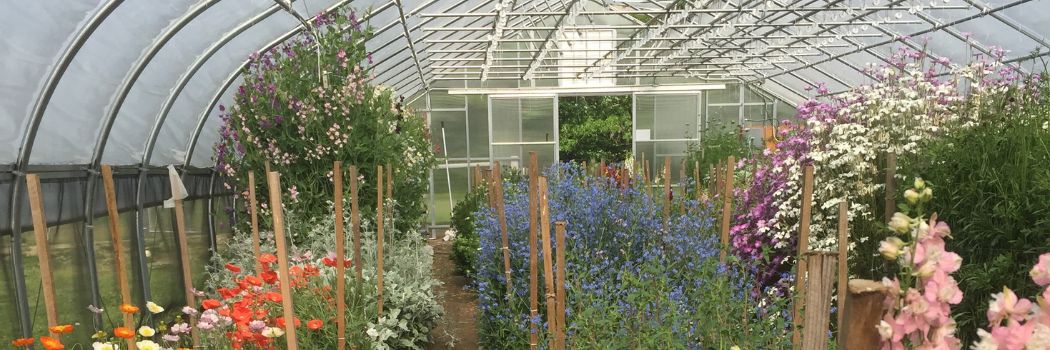- 3 Easy, Reliable, Productive Cut Flowers: Sunflowers, Zinnias & Rudbeckia
- 5 Factors That Determine Vase Life of Cut Flowers
- American Flowers Week: Combining the Art of Floral Design & Couture
- Celebrating the 8th American Flowers Week | Johnny's 2022 Botanical Couture
- Celebrate the 7th American Flowers Week | Johnny's 2021 Botanical Couture
- Collective Selling Models for Flower Farmers: Flower Hubs That Work
- 5 Cool Flowers to Plant Now | Lisa Mason Ziegler's Secrets for Growing Hardy, Cool-Season Annuals
- Cut-Flower Harvesting & Post-Harvest Care | Best Practices from Pros in the Slow Flower Community
- Cut-Flower Kit | Guide for Market Growers (PDF)
- Easy Cut-Flower Garden Map | For Growers New to Flowers (PDF)
- Easy Cut-Flower Garden Planner | For Growers New to Flowers (PDF)
- From Color to Climate: 5 Floricultural Trends Subtle & Seismic
- Flower Culture by Crop | Comparison Chart | Days to Germination, Weeks to Transplant, Days to Harvest (PDF)
- Flower Farmers' Favorite Fillers & Foliage | Recommendations from 3 Farmer-Florists
- Getting Started in Cut-Flowers | Top 15 Cuts
- Heat & Drought: How Flower Farmers Are Adapting to Changing & Challenging Climatic Conditions
- Intro to Overwintering Flowers | Method & Recommendations from Johnny's Overwinter Flower Trials
- An Introduction to Producer Marketing Cooperatives | M Lund & Associates
- How Day Length Affects Cut-Flower Production
- Flower Power for Roadside Markets
- Growing Flowers in Hoophouses & High Tunnels: Some Cool-Weather & Hot-Weather Options
- Tips for Starting a U-Pick Flower Operation
- Year-Round Flower Production Strategy
- Overwinter Flower Trials | Multiyear Results for >25 Crops | Johnny's Selected Seeds | XLSX
- Seeding Date Calculator | Johnny's Recommended Flowers for Overwintering | XLSX
- Just Add Flowers | An Introduction to Companion Planting for Vegetable & Herb Gardeners
- Sustainable Farming Methods | A Survey of Flower Farmers' Best Practices
- Pricing & Profitability for Flower-Farmers | Pointers from a Diversity of Pros
- Slow Flowers Palette & Petal Crushes | Evolving Colors & Shape-Shifts in Floral Industry Trends
- Johnny's & Slow Flowers | Johnny's Selected Seeds
- Slow Flowers | Celebrating Fifth-Season Regional Design Elements
- Slow Flowers Floral Forecast | A Summary of Industry Insights & Trends
- Slow Flowers | Building a Better Market Bouquet | Tips & Techniques for Flower Farmers
- Slow Flowers | Tips for Staging On-Farm Floral Workshops | Johnny's Selected Seeds
- Wedding Wisdom 101 | 10 Beginner Tips for Entering the Wedding Floral Landscape
- Succession-Planting Flowers | Scheduling & Planning, Sowing Frequency, Recordkeeping & Recommendations
- Succession-Planting Interval Chart for Flowers
- Sustainable Floral Design | Techniques & Mechanics for Foam-Free Floristry | Tobey Nelson & Debra Prinzing
- Video: Mason Jar Bouquet Tutorial
- Video: How to Build a Bouquet
- Video: Tobey Nelson | Sustainable Floral Design | Slow Flowers Summit
- Video: Economic Considerations in Overwintering Cut Flowers | Johnny's Selected Seeds
- Floral Stem Cutter | Instructions for Mounting, Use & Care | Tech Sheet (PDF)
- Top-10 Flowers for Direct-Seeding | 5 for Cool-Soil Sowing + 5 for Warm-Soil Sowing
- Video: Floating Row Cover | Baby "Cool Flower" Protection from Whipping Winter Winds
- Video: The Procona System for All-in-one Flower Harvest, Transport & Display
- Johnny's Overwinter Flowers Tunnel: Trellising, Supports, Ground Cover & Spacing
- Video: Irrigation Considerations for the Overwinter Flowers Tunnel | Johnny's Selected Seeds
- Video: Johnny's Overwinter Flowers Trial Recap
- Video: Producer Cooperatives for Small-Scale Farmers | Johnny's Webinar Series
- Climate Adaptation for Vegetable & Flower Farmers | Johnny's Educational Webinar Resources
- Webinar Slide Deck | Flower Growing in Southern States | PDF
- Bloom to Boom: Flower Farm Profitability
- Chrysal Professional 1 Hydration Solution | SDS
- Chrysal Professional 2 Transport & Display T-Bag | SDS
- Eat Your Flowers: Serve Up That Wow Factor With Edible Flowers
- Forcing Tulip Bulbs
- When to Start Seeds for Overwintered Flowers
- Introduction to Forcing Flower Bulbs in Soil
- Chrysal Clear Bulb T-Bag | Cut-Flower Conditioner | SDS
- Flower Growing in Southern States | Johnny's Educational Webinar Series
- Chrysal CVBN Flower Conditioner | SDS
- Video: Flower Growing in Southern States | Johnny's Webinar Series
- Chrysal Clear Universal Flower Conditioner | SDS
- Chrysal Clear Bulb Flower Conditioner | SDS
- Choosing Tulip Varieties for Forcing
- 10 Tips for Building a Profitable Cut-Flower Business
- Edible Flowers List: Top 20 Favorites from the Slow Flowers Community
- Choosing Flower Crops to Overwinter: Results from Our Trials
- Webinar Slide Deck | New-for-2023 Flowers & Floral Supplies | PDF
- Chrysal Classic Professional 2 Transport & Display (Holding) Solution | SDS
- Flowering in the South: Profiles of 5 flower farmers who cope with temperature, humidity, pest & weed pressure
- Chrysal Professional 3 Vase Solution Powder | SDS
Tips for Attracting Passersby to Your Farmstand or Cutting Garden
Driving through Delaware farm country on our way to the beach, I passed several roadside markets with large flower gardens along the road. They turned my head, which is exactly what was intended. And what better way to draw attention to a farm stand? A large patch of flowers has universal appeal, and can have the same visual impact as a wagonload of petunias in spring or a pile of pumpkins in autumn.
The key to attracting attention with flowers alongside roads and byways is to plant a lot of them. The patch needs to be big enough to present a solid block of color to passing motorists. The flowers should be profuse, cut-and-come-again varieties that will bloom all summer long.
One perfect flower for the job is the zinnia. Zinnias, the type commonly used for cut flowers, will bloom for months if kept dead-headed. Seed can be purchased in separate colors to create vivid patches of color. If the flowers aren't harvested regularly, they will branch lavishly to present even more color. What's more, zinnias are one of the least costly to plant, easiest to grow, and most reliable flowers available.
Zinnias can be planted in two or three rows per 4-foot-wide bed. The more beds, the better. They can be direct-seeded quickly with an Earthway® Seeder, using the Beet Seed Plate. For best branching, which leads to the most concentrated color, they should be thinned to 12" apart in each row.
The most visible color from a distance is yellow, so you might consider planting a patch of all-yellow zinnias. Other bright yellow flowers that bloom over a long period include the branching sunflowers (single-stem varieties will give you only one bloom per plant); rudbeckias; and African marigolds. These are all good for cutting, so you can either make bouquets to sell at the stand or let customers pick their own.
Another roadside attraction you can create with flowers is a butterfly garden. Many flowers, including zinnias, are attractive to butterflies. Another good flower for a butterfly garden — one that is highly visible from a distance — is asclepias, or butterflyweed. Asclepias curassavica, the yellow and orange butterfly milkweeds, can be especially attractive. Monarch caterpillars feed only on milkweeds, so a good stand of milkweed plants will attract egg-laying females. Although the plants will be damaged by the caterpillars, they recuperate after the larvae pupate and put on a good show of blooms by late summer. Johnny's also offers a Butterfly & Hummingbird Mix that can be broadcast sown to create an entire meadow.
Using flowers to draw attention to your business is a smart strategy on so many levels: it's more cost-effective than banners or signs, it can give you another product to sell, and it's good for the environment.
For more ideas about cut flowers, see my book, The Flower Farmer: An Organic Grower's Guide to Raising and Selling Cut Flowers.
Byczynski and her family have been growing vegetables and cut flowers since 1988, selling through CSAs, at farmers' markets, to chefs, grocery stores, and florists. They currently grow cut flowers and hoophouse tomatoes on about 2 acres of their 20-acre farm near Lawrence, Kansas.
She is also the author/editor of two of our favorite books about market farming, The Flower Farmer and The Hoophouse Handbook.



